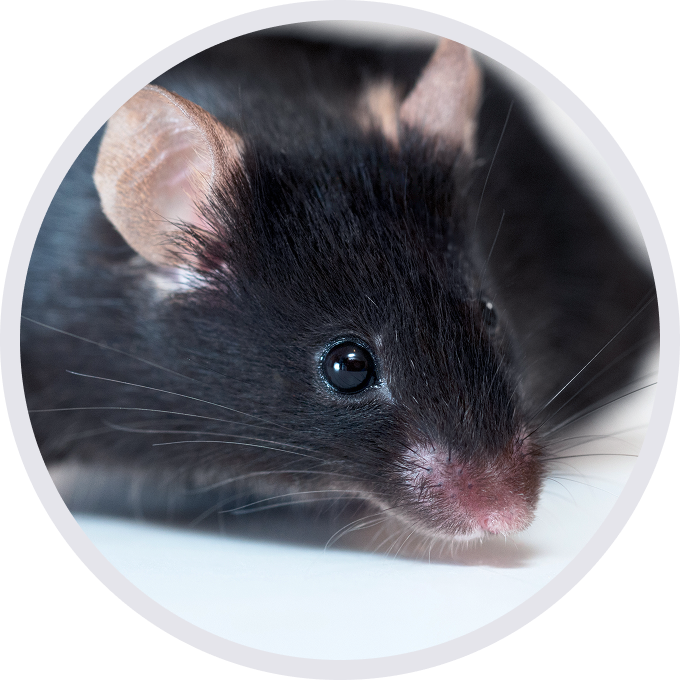
C57BL/6JNifdc-TgTn(Tol2-Thy1-hTARDBP*A315T, Thy1-hTARDBP*A315T)3/Bcgen • 113323

Western blot analysis of TDP-43 protein expression in transgenic F1 B-Tg(Thy1-hTARDBP*A315T) mice. Skeletal muscle were collected from wild-type C57BL/6JNidc mice (+/+) and transgenic F1 B-Tg(Thy1-hTARDBP*A315T) mice (Tg), and then analyzed by western blot with anti-TDP43 antibody (TDP-43 is encoded by TARDBP). 40 μg total proteins were loaded for western blotting analysis. GAPDH were detected as internal control. TDP-43 was detected in skeletal muscle in both wild-type and transgenic mice, as the antibody was cross-reactive between human and mouse. The quantitative results showed that TDP-43 expression is slightly upregulated in the transgenic B-Tg(Thy1-hTARDBP*A315T) mice.
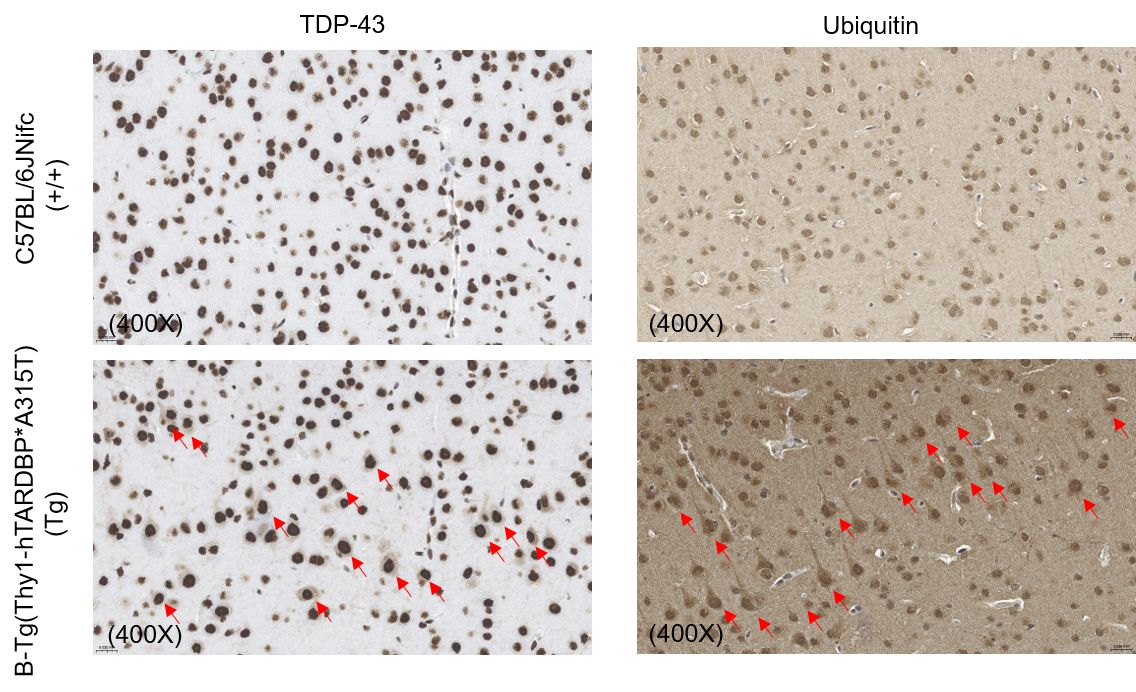
Immunohistochemical (IHC) detection of TDP-43 protein inclusions aggregates in the brain cortex of transgenic B-Tg(Thy1-hTARDBP*A315T) mice. The image showed TDP-43 inclusions aggregates in transgenic F1 B-Tg(Thy1-hTARDBP*A315T) mice (Tg, 12-week-old, male) and wild-type C57BL/6JNifdc mice (WT, 12-week-old, male) with a cross-reactive anti-TDP-43 antibody (abcam, ab109535) and anti-ubiquitin antibody (abcam, ab134953) at 400× magnification. Red arrows highlighted cytoplasmic TDP-43 inclusions and ubiquitin characteristic of pathological deposition.

Histopathological analysis of skeletal muscle tissue in transgenic B-Tg(Thy1-hTARDBP*A315T) mice. The image demonstrates muscle atrophy with partial myofiber degeneration in transgenic F1 B-Tg(Thy1-hTARDBP*A315T) mice (Tg, 12-week-old, male) but not in wild-type C57BL/6JNifdc mice (WT, 12-week-old, male). The affected myofibers exhibit a characteristic wavy appearance, indicative of underlying pathological changes within the muscle tissue in transgenic B-Tg(Thy1-hTARDBP*A315T) mice.
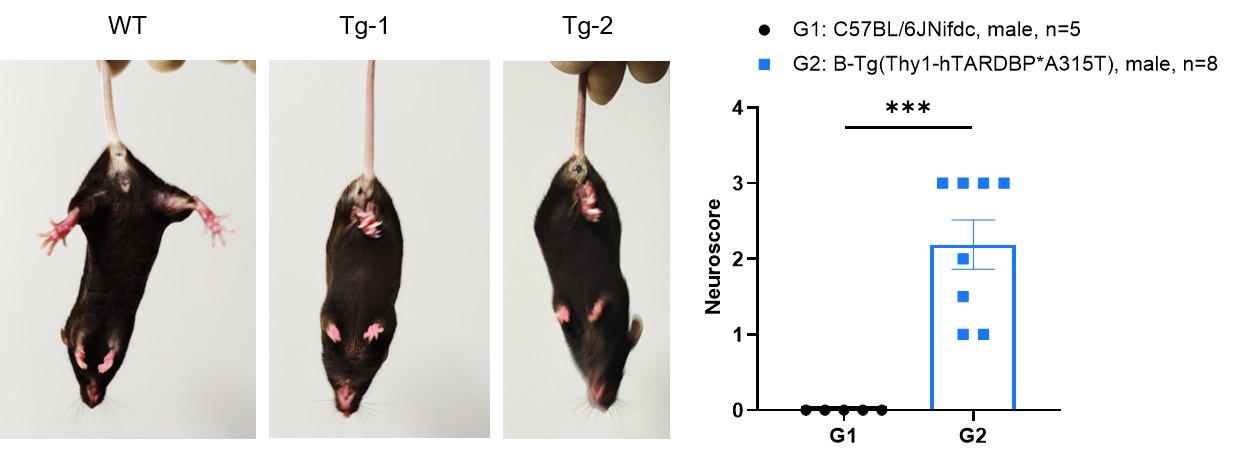
Behavioral performance in wild-type C57BL/6JNifdc and transgenic B-Tg(Thy1-hTARDBP*A315T) mice. Clasping tests were conducted to assay the behavioral performance in wild-type C57BL/6JNifdc (male, 12-week-old, n=5) and transgenic B-Tg(Thy1-hTARDBP*A315T) mice (F1, male, 12-week-old, n=8). Left, picture showed that transgenic B-Tg(Thy1-hTARDBP*A315T) mice do not splay their hindlimbs when suspended by their tails. Right, transgenic B-Tg(Thy1-hTARDBP*A315T) mice show significantly higher Neuroscores (1~3) versus wild-type mice (~0) , suggesting impaired neurological function. Values are expressed as mean ± SEM. Significance was determined by unpaired t-test, ***P < 0.001.
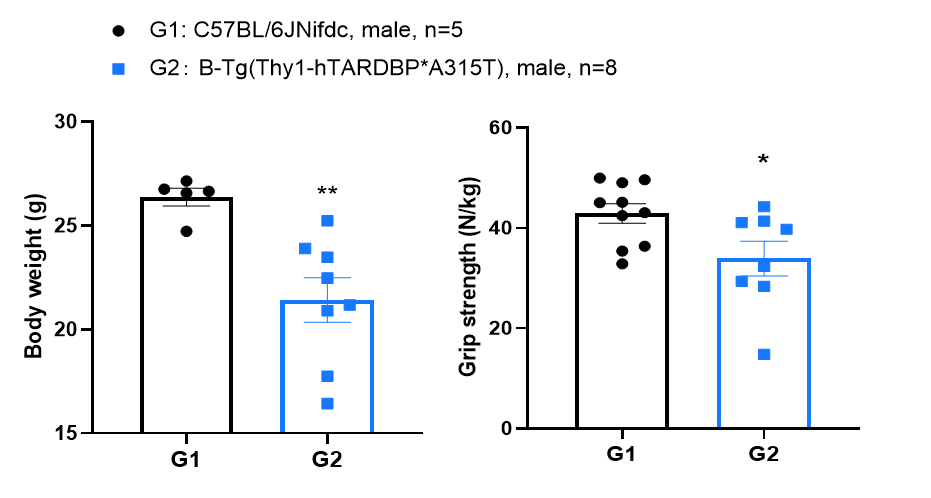
Behavioral performance in wild-type C57BL/6JNifdc and transgenic B-Tg(Thy1-hTARDBP*A315T) mice. Grip strength tests were conducted to assay the behavioral performance in wild-type C57BL/6JNifdc (5 male, 12-week-old) and transgenic B-Tg(Thy1-hTARDBP*A315T) mice (F1, male, 12-week-old, n=8). Grip strength results showed the strength produced by forelimb was decreased in transgenic B-Tg(Thy1-hTARDBP*A315T) mice, showing grip strength impairments of transgenic mice. All grip strength measurements are normalized to the individual animal’s body weight. Right, Clinical score of mice with amyotrophic lateral sclerosis. Values are expressed as mean ± SEM. Significance was determined by unpaired t-test. *P < 0.05, **P < 0.01, ***P < 0.001.
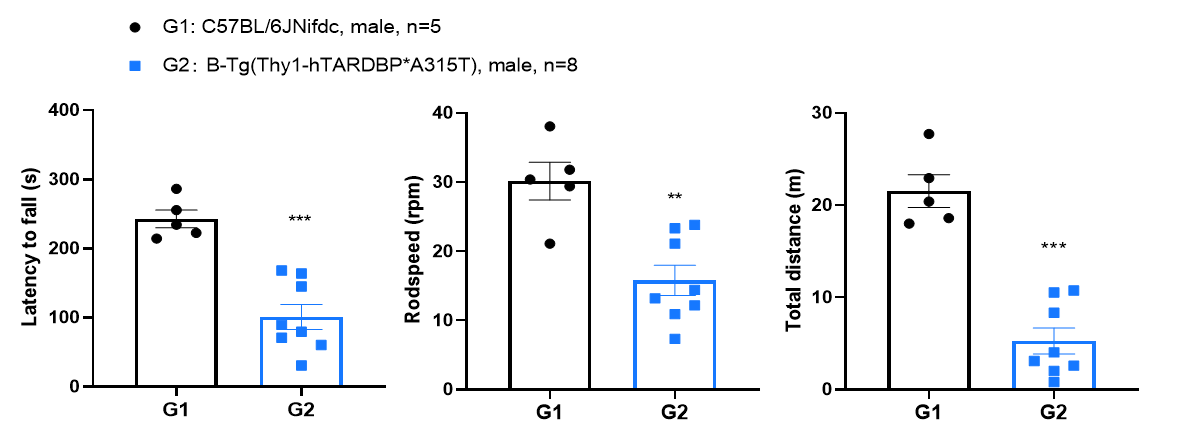
Behavioral performance in wild-type C57BL/6JNifdc and transgenic B-Tg(Thy1-hTARDBP*A315T) mice. Rotarod tests were conducted to assay the behavioral performance in wild-type C57BL/6JNifdc (male, 12-week-old, n=5) and transgenic B-Tg(Thy1-hTARDBP*A315T) mice (F1, male, 12-week-old, n=8). The latency to fall, rodspeed and total distance were decreased in transgenic B-Tg(Thy1-hTARDBP*A315T) mice, showing motor impairments of transgenic mice. Values are expressed as mean ± SEM. Significance was determined by unpaired t-test. *P < 0.05, **P < 0.01, ***P < 0.001.
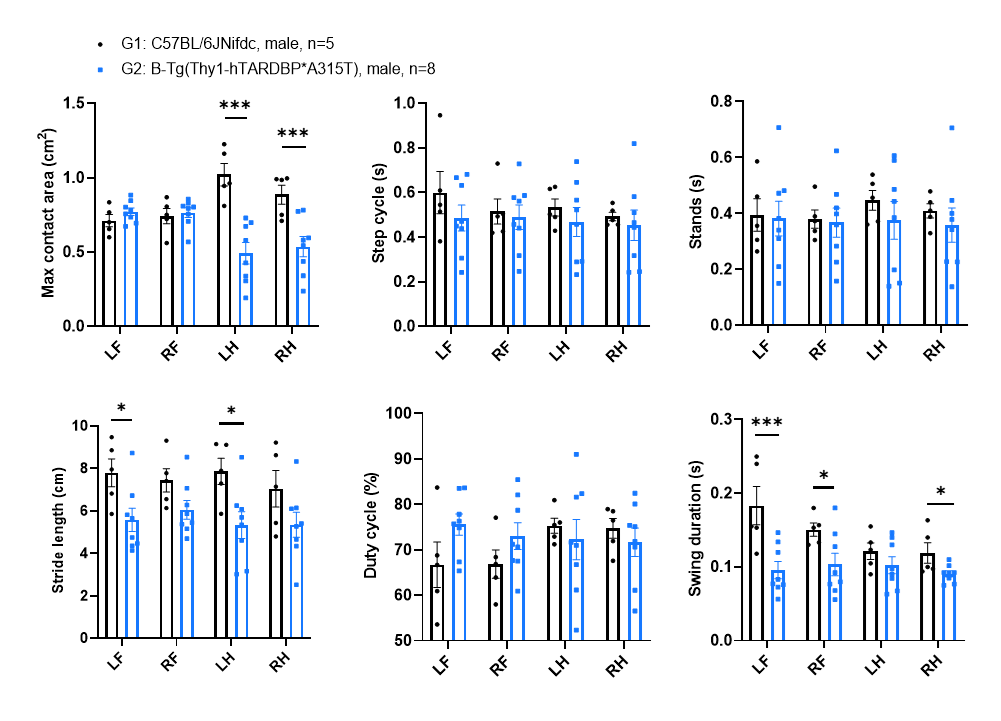
Gait analysis of wild-type C57BL/6JNifdc and transgenic B-Tg(Thy1-hTARDBP*A315T) mice. Gait analysis were conducted to assay the behavioral performance in wild-type C57BL/6JNifdc (male, 12-week-old, n=5) and transgenic B-Tg(Thy1-hTARDBP*A315T) mice (F1, male, 12-week-old, n=8). The transgenic B-Tg(Thy1-hTARDBP*A315T) mice exhibit significantly different gait characteristics across multiple gait parameters, indicating that the locomotor ability and coordination of the transgenic mice are abnormal. Data were represented as mean ± SEM. Statistical analysis was performed using unpaired two-way ANOVA. * p ≤ 0.05, ** p≤ 0.01, *** p ≤ 0.001. RF, right front paw. LF, left front paw. RH, right hind paw. LH, left hind paw.